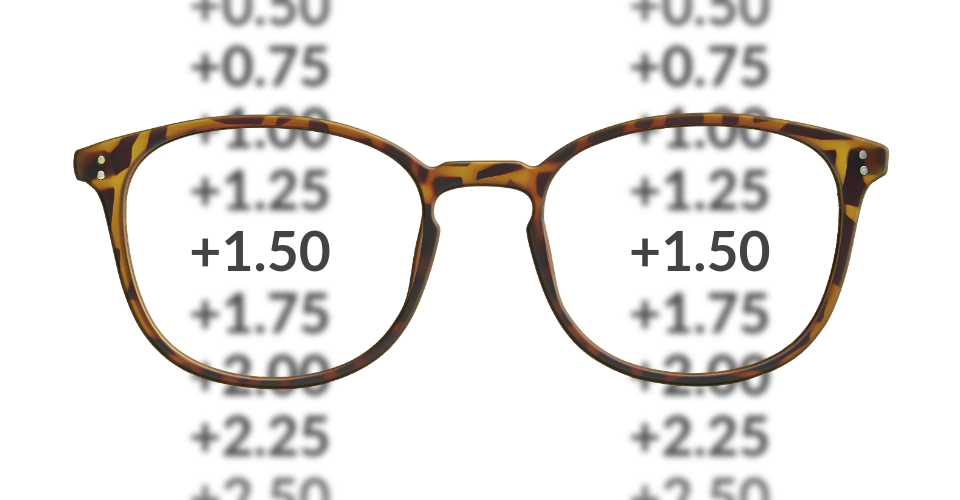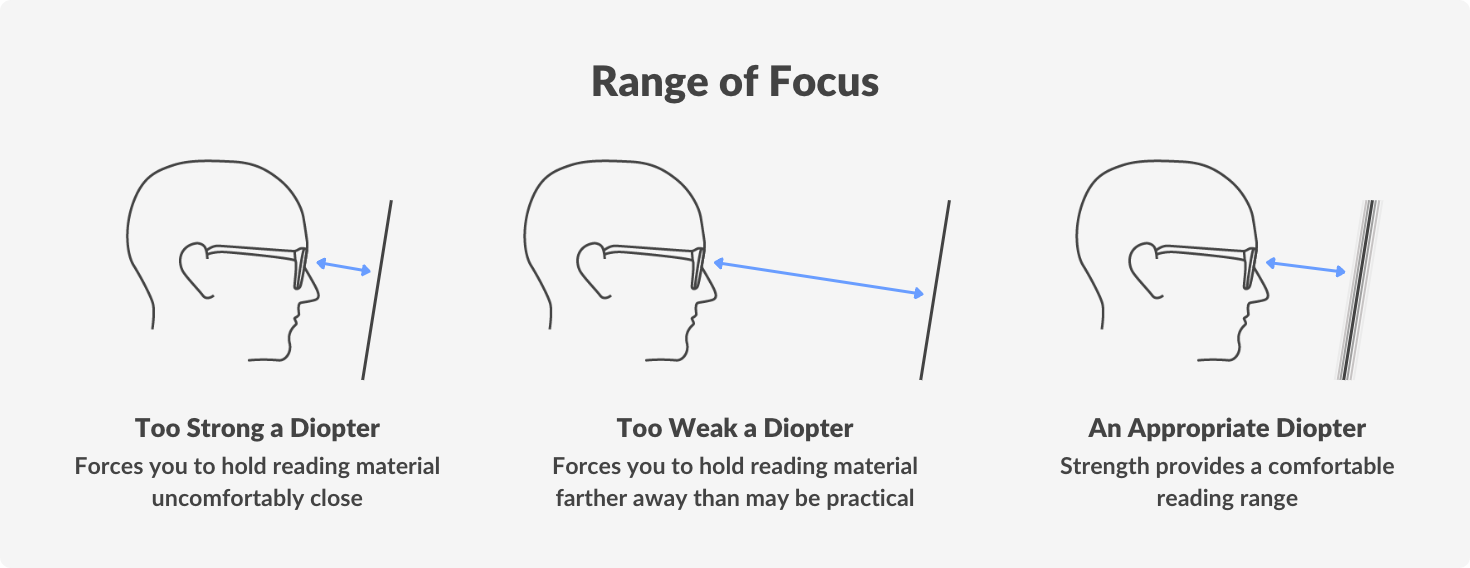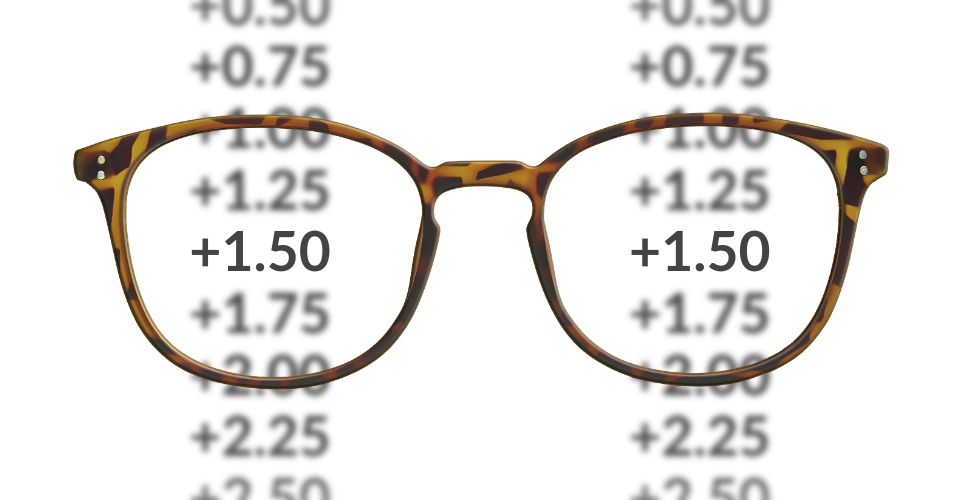
Reading Glasses
Magnifying lenses to help you improve close range vision

Reading
Glasses
What are reading glasses?
Reading glasses are designed with high quality lenses that magnify and make it easier to see or read anything up close.
What are reading glasses?
Reading glasses are designed with high quality lenses that magnify and make it easier to see or read anything up close.




Do I need reading glasses?
As we get older, our eyes weaken, and we begin to lose the ability to focus on objects up-close. Reading glasses feature magnifying lenses which enlarge anything in our viewing area, making close range items like text look clearer.
Reader glasses strengths
The strength of the lenses, called diopters, will vary based on your age, vision and how you use your glasses. A +1.00 pair indicates a strength of one diopter. Diopter levels usually increase by +0.5 and range from +1.00 to +4.00.


Do I need reading glasses?
As we get older, our eyes weaken, and we begin to lose the ability to focus on objects up-close. Reading glasses feature magnifying lenses which enlarge anything in our viewing area, making close range items like text look clearer.
Reader glasses strengths
The strength of the lenses, called diopters, will vary based on your age, vision and how you use your glasses. A +1.00 pair indicates a strength of one diopter. Diopter levels usually increase by +0.5 and range from +1.00 to +4.00.


Everything you need to know about reading glasses
Recommended frames for reading glasses
Everything you need to know about reading glasses
Recommended frames for reading glasses
Our optical experts
Our optical experts

Maria Horan FBDO
Dispensing optician
Maria holds a BSc Honours in Ophthalmic Dispensing and has over 17 years of optical experience.
Learn more

Beck Jinnette
Dispensing optician
Beck has over 17 years of experience in eye care and holds her Certificate IV in Dispensing in Australia.
Learn more

Sharlene McKeeman FBDO
Dispensing optician
Sharlene is a qualified dispensing optician and member of the Association of British Dispensing Opticians.
Learn more

Speak to a qualified dispensing optician
Got questions about eye care? We're here to help.
For guidance you can trust, ask our in-house dispensing opticians.
For guidance you can trust, ask our in-house dispensing opticians.
Ask our dispensing opticians
Your request was successfully submitted!
FAQs
Reading glasses are not only designed for reading, but for seeing up-close objects clearer. Whether reading, looking at a tablet, or focusing on another hands-on activity, most people view anywhere between 45 to 55 cm from their eyes. Reading glasses offer lens power optimised for that range.
Reading glasses do not correct visual conditions and are only designed for seeing objects up-close more clearly. Reading glasses are non-prescription and should only be worn by those who do not require a vision prescription and who do not have an astigmatism. If you require a different prescription in each eye, readers are not a good choice as you cannot get them with different prescriptions in each lens. Wearing the wrong prescription will cause eyes to be over or under corrected, leading to eye strain or headaches.
It is not recommended to wear reading glasses if you have astigmatism. Reading glasses do not account for the CYL, causing your vision to remain blurred.
No one should wear reading glasses all day, especially while walking or driving. Wearing reading glasses while doing activities that require a wider scope of vision may cause a headache, eye strain, or even eye damage.
Reading glasses can be purchased over the counter without a prescription, but it is highly recommended that you receive a yearly eye exam to ensure your eyes are healthy.
If this is your first time purchasing reading glasses, you may not know what lens strength is best for you. The best way to find out which power you need is to consult with your eye doctor to ensure you choose the correct one.
FAQ
Reading glasses are not only designed for reading, but for seeing up-close objects clearer. Whether reading, looking at a tablet, or focusing on another hands-on activity, most people view anywhere between 45 to 55 cm from their eyes. Reading glasses offer lens power optimised for that range.
Reading glasses do not correct visual conditions and are only designed for seeing objects up-close more clearly. Reading glasses are non-prescription and should only be worn by those who do not require a vision prescription and who do not have an astigmatism. If you require a different prescription in each eye, readers are not a good choice as you cannot get them with different prescriptions in each lens. Wearing the wrong prescription will cause eyes to be over or under corrected, leading to eye strain or headaches.
It is not recommended to wear reading glasses if you have astigmatism. Reading glasses do not account for the CYL, causing your vision to remain blurred.
No one should wear reading glasses all day, especially while walking or driving. Wearing reading glasses while doing activities that require a wider scope of vision may cause a headache, eye strain, or even eye damage.
Reading glasses can be purchased over the counter without a prescription, but it is highly recommended that you receive a yearly eye exam to ensure your eyes are healthy.
If this is your first time purchasing reading glasses, you may not know what lens strength is best for you. The best way to find out which power you need is to consult with your eye doctor to ensure you choose the correct one.











































